Utilities in Washington may have to use more renewable sources
WASHINGTON STATE - Olympia voters will get to choose whether to require state utility companies to increase renewable energy sources to 15 percent of their supply by 2020.
Elections officials announced that Initiative 937, which would also require utilities to invest in energy conservation programs, qualified for the November ballot.
Supporters say the measure would stabilize rates for electricity customers, offer economic development opportunities for rural communities and add jobs, all while helping lower emissions.
"It sets the stage for us to have a diverse energy mix that's clean and affordable," said Bryan Flint, spokesman for the I-937 campaign. "It's a reasonable measure and it puts the market pressures into place so that investors in solar, wind and biomass know that there's a steady future for their investments."
During July, sponsors submitted more than 337,000 voter signatures for Initiative 937, exceeding the 225,000 valid signatures needed to qualify for the ballot, as well as the cushion that is required to cover duplicate or invalid signatures.
A check of about 10,300 randomly selected voter signatures showed an invalidation rate of about 24 percent. They could have had an invalidation rate as high as 33 percent and still qualified, elections officials said.
Under the initiative, utilities with more than 25,000 customers would have to meet 15 percent of their annual load with resources such as wind power, solar energy or sewage gas.
If the initiative is approved by voters, Washington will join the 20 other states, and the District of Columbia, that have a so-called renewable portfolio standard; Maine has the highest, at 30 percent.
Under current law, utilities are already required to offer customers the option of investing in renewable energy, by paying extra on their monthly bill.
Related News

New Orleans Levees Withstood Hurricane Ida as Electricity Failed
NEW ORLEANS - Infrastructure in the city of New Orleans turned in a mixed performance against the fury of Hurricane Ida, with the levees and pumps warding off catastrophic flooding even as the electrical grid failed spectacularly.
Ida’s high winds, measuring 150 miles (240 kilometers) an hour at landfall, took out all eight transmissions lines that deliver power into New Orleans, ripped power poles in half and crumpled at least one steel transmission tower into a twisted metal heap, knocking out electricity to all of the city. A total of more than 1.2 million homes and businesses in Louisiana and Mississippi…




